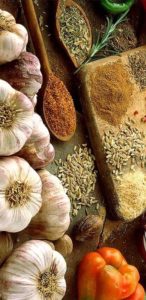From our list of herbs and spices, the following are recommended for Gallbladder:
Scroll down for links.
- Dandelion
- Fennel Seed
- Garlic
- Ginger
- Hemp Oil
- Nettle
- Rosemary
- Tumeric
- Yellow Dock
Natural Cures and Remedies for Gallbladder
Organs or systems affected Gallbladder, gastroin-testinal system Therapeutic actions Tonic, laxative, diuretic Nature Bitter, sweet, cooling, slightly moist Plant constituents Inulin, terpenes, flavonoids, beta carotene, vitamins C and K Flower essence Used when possessive or manipu-lative behaviors disguised as love are present, and for those who are demanding or emotionally needy, who seek attention through negative behavior, or who su?er from self-centeredness

Supports bile production Chicory’s bitter princi-ple is helpful for stubborn or chronic gallblad-der congestion. It helps open up the bile ducts, decreasing gallbladder colic. Contraindications Generally regarded as safe.
Dandelion, Fennel Seed, Garlic, Ginger, Hemp Oil, Nettle, Rosemary, Tumeric, Yellow Dock
Organs or systems affected Gallbladder, heart, stomach Therapeutic actions Tonic, bitter, febrifuge Nature Bitter Plant constituents Bitter glycosides, alkaloids, volatile oil, acids, resin, flavonoids, magnesium Flower essence Indicated for those who need to act from strength of inner purpose and who need help saying “no” when appropriate
Contraindications, Interactions, and Side Effects (Turmeric) – Class 2b. Emmenagogue and uterotonic. Contraindicated in patients with bile duct obstruction, gallstones, hyperacidity, and stomach ulcers (AHP; AEH). While in moderate doses, turmeric is said to inhibit cancers, lym-phomas and ulcers, overdoses of curcuminoids may possibly be cytotoxic and ulcerogenic, and may lead to diminution of red and white corpuscles. Still, Commission E approves 1.5-3 g/day, not nearly enough to provide 1200 mg curcumin. Commission E also reports contraindications: biliary obstruction; adverse effects: GI irritation from continued use; consult physicians before using if a patient has gallstones (BIS; KOM). At 10% of diet, turmeric caused some loss of hair in rats (MAB). Care should be taken in women who wish to conceive or patients complaining of alopecia (MAB). Rather frightening what one reads in UPW (2000): Laboratory animals treated with it are reported to have been rendered entirely infertile. Women who are pregnant, or children (not yet widely in children) with gallbladder or liver disease or ulcers, should avoid turmeric (WAM). Limit internal use to 10 days (WAM).
Cleanses and tones liver and gallbladder Bogbean is a supreme bitter. As with most, it is a reputable herb to cleanse and tone the liver and gallbladder. Regulates female hormones In Germany, bogbean is referred to as moonflower, indicative of its use as a women’s hormone regulator-probably because of its strong e?ects on the liver, which regulates hormones.
Dandelion
Fennel Seed
Garlic
Ginger
Hemp Oil
Nettle
Rosemary
Tumeric
Yellow Dock
I have a great respect for the taxonomic diggings of Art Tucker, who has tried to clarify the differences between the European corn mint, Mentha arvensis, and the North American corn or field mint, Mentha canadensis. So, under Mentha arvensis I have aggregated most data from European workers or those Americans who are strongly influenced by them. Strangely, Moerman (DEM below), working with American Indians, had very separate entries for M. arvensis, which he called wild mint, and Mentha canadensis, which he called Canadian mint. I suspect that only Tucker and Debaggio, of the references cited, are capable of distinguishing the microspecies of mints. PH2 indicates it for “liver and gallbladder complaints” but contraindicates it for
